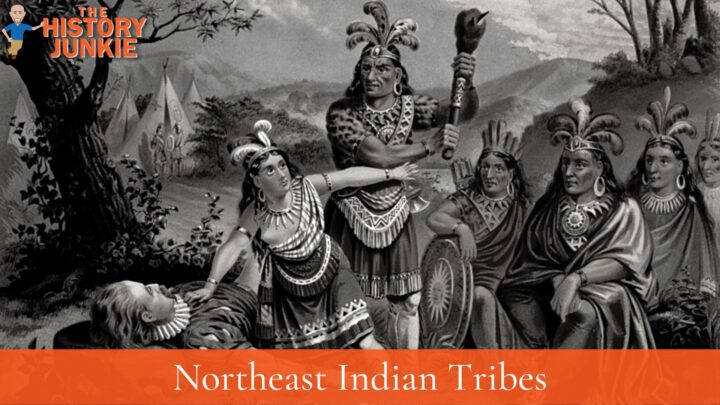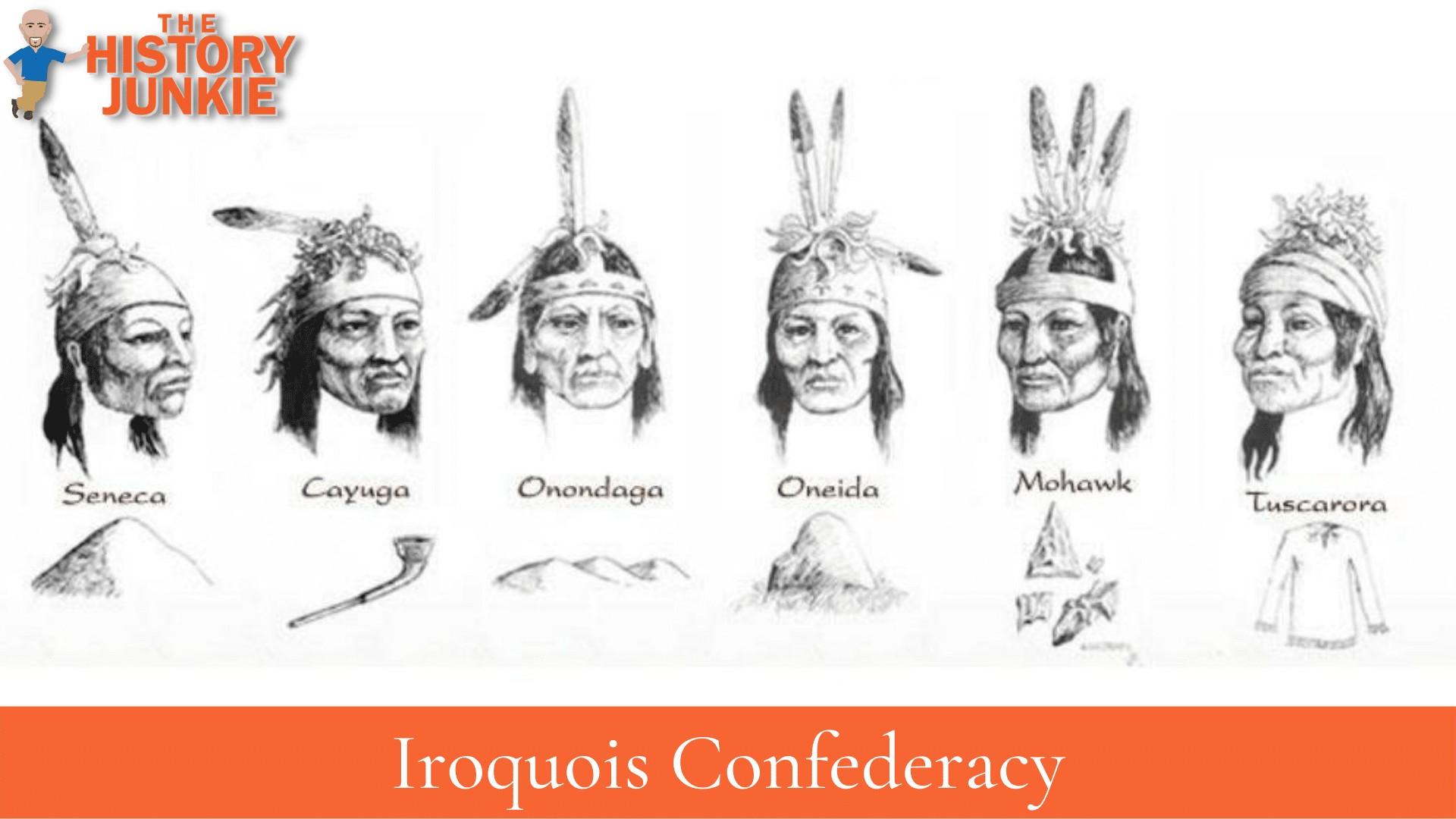The Northeast Indian Tribes are also known as the Eastern Woodland Indians since most of them live in the forest. These would have been the first Native Americans that the English, French, and Dutch explorers would have made contact with when they first arrived in the New World.

Some of the famous individuals that came from this group are as follows:
- Squanto
- Samoset
- Chief Massasoit
- Pocahontas
- Pontiac
Each of the Northeast Indian Tribes can be divided into three groups due to their language:
- Algonquian
- Iroquoian
- Siouan
They populated the areas up and down the Atlantic Coast to the Appalachian Mountains, with the most powerful Indian nation being the Iroquois Confederation.
While each of the Northeastern Indian Tribes has similarities, it is important to study each tribe individually as you will discover how different each tribe was and how each tribe had its own history.
Here is a list of the Northeast Indian Tribes:
Abenaki - One of the Algonquian-speaking peoples. They Lived in parts of Canada and the Northeast United States until being pushed west during American expansion. Unlike some of the more powerful Indian tribes, the Abenaki were fragmented into different subsets.
Algonquin - a small tribe in northern Michigan and Canada that was forced further north after the formation of the Iroquois Confederation.
Cayuga - made their home in what became the New York colony, whose name meant "people of the swamp." They were one of the original tribes to join the Iroquois Confederacy and are considered Iroquois, along with the Mohawk, Oneida, Seneca, Onondaga, and Tuscarora tribes.
Chippewa - originally occupied large amounts of land around Lake Huron and Lake Superior and south in Michigan, Wisconsin, and Minnesota when their lifestyle was of the Northeast woodland cultural group. They were hunters, fishers, and farmers.
Erie - They were once a powerful tribe. However, became extinct after the Iroquois Confederacy decimated them in the 17th century.
Illinois Confederacy - They are sometimes referred to as the Illiniwek or Illini, a group of 12–13 Native American tribes in the upper Mississippi River valley of North America.

Iroquois Confederacy - A confederation of five and eventually six Indian tribes that populated upper New York state. The area they resided in played a crucial role during the French and Indian War, which placed a high value on the Iroquois nations.
Kickapoo - An Algonquian-speaking tribe that was located around modern-day Indiana. The tribe's first contact with the Europeans was through the explorer Robert de La Salle during the La Salle expeditions.
Lenape - A large tribe that lived in the United States and Canada. They dealt quite a bit with William Penn when he arrived in Colonial America. They would side with the French and then later the British during the French and Indian War.
Lumbee - Their beginnings are a bit muddled. They became known due to their action against the Klu Klux Klan in the 1950s. They may have participated in the American Revolution, but it is unclear as to what side.
Maliseet - They were an Algonquian-speaking tribe of the Wabanaki Confederacy. They are the natives of the Saint John River valley and its tributaries, and their territory extends across the current borders of New Brunswick and Quebec in Canada and parts of Maine in the United States.
Menominee - They are part of the Algonquian language family of North America and are made up of several tribes that were located around the Great Lakes. They are considered one of the historic tribes of upper Michigan and Wisconsin and occupy about 10,000 acres.
Miami - Originally spoke one of the Algonquian languages. Among the peoples known as the Great Lakes tribes, it occupied territory that is now identified as Indiana, southwest Michigan, and western Ohio.
Micmac - They resided around Nova Scotia, Quebec, and the northeast of Maine. The tribe still maintains a population of 170,000 people.
Mohawk - lived in what would become the New York colony. They were the most powerful tribe in the Confederacy and played important roles during the French and Indian War, the American Revolutionary War, and the War of 1812
Mohegan - A federally recognized tribe living on a reservation in the eastern upper Thames River valley of south-central Connecticut. They were originally based in Massachusetts Bay
Mohican - Occupied the upper Hudson River Valley around where modern-day Albany, New York is located. They had a conflict with the Mohawk Tribe in the late 17th century during the Beaver Wars and were driven southeast into Massachusetts Bay.
Montauk - located across the Long Island Sound, which was part of Connecticut and Rhode Island Colony. and was an Algonquian-speaking tribe. They are related to the Pequot and Narragansett tribes that lived across the New England Colonies.
Munsee - a subtribe of the Lenape. They originally were one of three great divisions of the Lenape nation and lived around the upper portion of the Delaware River. They generally populated New York, New Jersey, and Pennsylvania.
Nanticoke - The Nanticoke tribe was a northeast tribe located around Delaware. They later moved to Canada and Oklahoma. The Nanticoke tribe was a people group that consisted of several tribes: Nanticoke proper, Choptank, Assateague, Piscataway, and Doeg.
Narragansett - One of the more influential tribes in New England during the settlement of early Colonial America. The first European to make contact with them was Giovanni de Verrazzano in 1524. They participated in King Philip's War despite Roger Williams pleading for them to stay neutral.
Niantic - Overwhelmed by the Pequot Indians in the region and were split up into two different tribes, Western Niantic and Eastern Niantic. The Western Niantics were subjects of the Pequot, and the Eastern Niantics became close allies to the Narragansetts.
Nipmuc - Descended from the Algonquian peoples from Massachusetts. The tribe first encountered the colonists of Colonial America in Massachusetts. Smallpox would decimate their population, as would their participation in King Philip's War.
Nottoway - A Native American tribe that resided in Virginia and spoke the language of the Iroquois. They were friendly with the early English settlers, but as America grew, the tribe would be lost to disease and expansion.
Oneida - They would become one of the few Native American tribes to side with the Americans during the American Revolutionary War. Later, they would be removed from their lands and pushed toward Wisconsin. Today, they are federally recognized in Wisconsin and New York.
Onondaga - Became a central location for the Iroquois Confederacy as it was located in the middle. Many of the most powerful leaders of the tribe would meet in the capital of the Onondaga Indian tribe to discuss important issues. This led to the Onondaga tribe being named "The Keepers of the Fire"
Ottawa - The Ottawa Indian tribe lived along the Ottawa River in eastern Ontario and western Quebec. They were an Algonquian-speaking Indian tribe, therefore, related to the Lenape tribe and enemies of the Iroquois and Wyandot. They aggressively fought against American Expansion.
Passamaquoddy - Tribe that lived around the area of Maine, United States, and New Brunswick, Canada. These were some of the first Native Americans that the French came in contact with when they were exploring the New World.
Penobscot - Was part of the Wabanaki Confederacy along with Abenaki, Passamaquoddy, Maliseet, and Micmac tribes. They are considered Northeastern Indian Tribe and, at the time of European contact, lived in Maine.
Pequot - Dominated the Connecticut landscape until the Pequot War, which devastated their population and caused them to relocate.
Pocomtuc - a prominent Native American tribe in Massachusetts Bay Colony. However, very little is known of their history as it faded over time.
Potawatomi - They were part of a long-term alliance, called the Council of Three Fires, with the Ojibwe and Ottawa. In the Council of Three Fires, the Potawatomi were considered the "youngest brother" and were referred to in this context as Bodéwadmi, a name that means "keepers of the fire" and refers to the council fire of three peoples.
Powhatan - A powerful tribe that influenced much of the political landscape in the area of Virginia. They are well-known in American History due to their role at Jamestown and the role of Pocahontas in saving Captain John Smith.
Quinnipiac - Resided in the modern state of Connecticut. The Quinnipiac spoke the Algonquian language and would be the first tribe put on a reservation by the English in 1638. The tribe no longer exists today.
Sauk - An Algonquian-speaking Northeast Indian Tribe that developed around northern New York and migrated to what is now eastern Michigan.
Sac and Fox - The earliest known location of the Sac and Fox Tribe was on the Michigan Peninsula. Here, they lived for centuries prior to European contact. They were an Algonquian-speaking tribe like many other Northeast Indian Tribes and were neighbors of the Ojibwe and Ottawa tribes.
Seneca - Part of the Iroquois Confederacy and one of the more dominant Northeast Indian Tribes. It is believed that their territory extended to the Allegheny River, and this was due to the Iroquois' successful conquest of the Wenrohronon and Erie nations in the 17th century.
Shawnee - A well-known tribe that was known for their excellent warriors. They fought against the Americans throughout their expansion. They are most well-known for their actions against Daniel Boone's daughter.
Shinnecock - Located on Long Island and was among 13 other Indian tribes in the area. Although they shared similar languages, kinship, and even relations with the other tribes, the people remained decentralized.
Susquehannock - A Native American tribe that lived near the Susquehanna River in what's now the southern part of New York. While they lived near the tribes of the Iroquois Confederacy, they were never part of it. Their lands spread through Pennsylvania and the upper Delaware River and even extended into Maryland.
Wampanoag - Most notable Northeastern tribe in Colonial America. They were the tribe that greeted the Pilgrims when they arrived in Plymouth. They would help them survive and become an ally for many decades until King Philip's War.
Wappinger - They were one of the few tribes that supported the Americans during the American Revolution in hopes that it would lead to better treatment. However, this did not happen. After their leaders were killed during the war, they would begin a slow fade to extinction.
Winnebago - Located in northeastern Wisconsin, close to modern-day Green Bay. They were a powerful tribe in the region and dominated the western shore of Lake Michigan and the Upper Peninsula.
Wyandot - Originally known as the Huron Indians, their name changed over time to the Wyandot, which is how they are recognized today. The Wyandot were the last Native American tribe to leave Ohio.
Study each of these tribes individually rather than generalize them. Some of them lived in longhouses, while some preferred wigwams.
Each of them had different forms of culture and government
